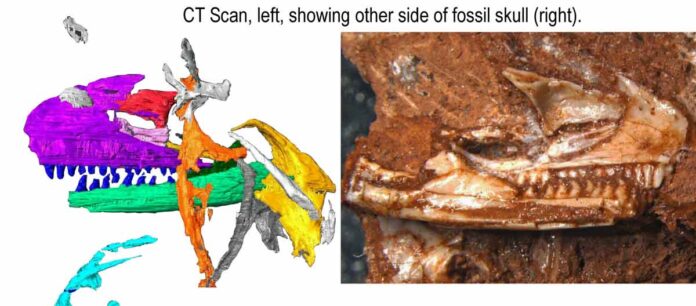A fossil discovered in a cupboard at the Natural History Museum in London. It has pushed the origins of the modern lizard back 35 million years.
The scientist who made the discovery believes it is one of the most significant discoveries in this field in recent decades.
The fossilized relative of living lizards, such as monitors, the gila monster, and slow worms was discovered in a quarry. It was near the village of Tortworth in Gloucestershire, south-west England, in the 1950s.
As a modern-type lizard, the new fossil influences all estimates of the origin of lizards and snakes. It is known collectively as the Squamata. It will also influence assumptions about their rates of evolution and even the key trigger for the group’s origin.
The team was led by Dr. David Whiteside of the University of Bristol’s School of Earth Sciences. They have named their amazing discovery Cryptovaranoides microlanius. It means “small butcher,” in honour of its jaws. Because they were filled with sharp-edged slicing teeth.
“I first noticed the specimen in a cupboard full of Clevosaurus fossils in the storerooms of the Natural History Museum in London. There I am a Scientific Associate,” Dr. Whiteside explained. This was a fairly common fossil reptile and a close relative of the New Zealand Tuatara. It is the sole survivor of the Rhynchocephalia group, which split from the squamates over 240 million years ago.
The braincase, neck vertebrae, shoulder region, presence of a median upper tooth in the front of the mouth, the way the teeth are set on a shelf in the jaws, and skull architecture such as the lack of a lower temporal bar distinguish Cryptovaranoides from Rhynchocephalia.
There is only one major primitive feature that is not found in modern squamates. It is an opening on one side of the upper arm bone, the humerus, through which an artery and nerve pass. Cryptovaranoides does have some other seemingly primitive characteristics. Such as a few rows of teeth on the bones of the roof of the mouth. But this has been observed in the living European Glass lizard, and many snakes, such as Boas and Pythons. They have multiple rows of large teeth in the same area. Despite this, it has a braincase that is advanced in comparison to most living lizards. The bone connections in the skull indicate that it was flexible.
Dr. Whiteside said, “This is a very special fossil that will most likely become one of the most important discoveries in the last few decades. It is fortunate that it is part of a National Collection, in this case the Natural History Museum in London. We would like to express our gratitude to the late Pamela L. Robinson. As she recovered the fossils from the quarry and prepared the type specimen and associated bones. It was a shame she didn’t have access to CT scanning technology to help her observe all of the specimen’s details.”

